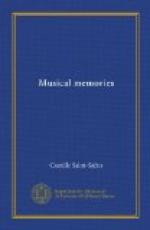The first act of Orfeo ends in a tumultuous effect of the stringed instruments which was evidently intended to indicate a change of scene and the appearance of the stage settings of the infernal regions. This passage does not appear in the French Orphee and it is lacking in the engraved score, where it is replaced by a bravura aria of doubtful taste, accompanied by a single quartet. Whether the stage managers wanted an entr’acte or the tenor, Legros, demanded an effective aria, or for both these reasons, a reading of the manuscript indicates how absolutely the author’s meaning was changed. There is no doubt that except for some such reason he would have changed this aria and put it in harmony with the rest of the work.
For a long time this aria was attributed to Bertoni, the composer, and Gluck was accused of plagiarizing it. As a matter of fact, and to the contrary, this aria came from an older Italian opera of Gluck’s. Bertoni not only imitated it in one of his scores, but he had the hardihood to write an Orfeo on the text already followed by Gluck in which he plagiarized the work of his illustrious predecessor in a scandalous fashion.
This same aria, changed with real genius and performed with prodigious eclat by Madame Viardot, and re-orchestrated by myself, was one of the strongest reasons for the success of the famous performances at the Theatre-Lyrique. But it is well understood that it could not properly find a place in an edition where the sole end was artistic sincerity and purity of the text.
From this point of view it would seem that the best manner of giving Orphee would be to conform to the author’s definitive version. A tenor would have to take the part of Orpheus, since we no longer have male contraltos, and to keep to this kind of a voice in Orphee we would have to have recourse to what is called, in theatrical terms, a travesti. There are obstacles to this, however. The pitch has changed since the Eighteenth Century; it has gone up and it is now impossible, or nearly so, to sing the role written for Legros. The contraltos of the Italian chorus have become the counter-tenors, who, for the same reason, find themselves struggling with too sharp notes.
In the Seventeenth Century the French pitch was even more flat, and it is a great pity, for it is almost impossible to perform our old music, on account of the insuperable obstacles. This is not the case in Germany, however, or in Italy, and that is the reason why the works of Sebastian Bach and Mozart can be sung. The same is true of Gluck’s Italian works.
This was the reason that Doret gave the part of Orpheus to a contralto, just as is done at the Opera-Comique. The poetic character of the part of Orpheus lends itself excellently to such a feminine interpretation. But in resuming the key of the Italian score, it is necessary to go back, at least to a considerable degree, to the instrumentation. By a curious anomaly the beautiful recitative, accompanied by the murmur of brooks and the songs of the birds, is in C major in both scores. The author could not have changed them. On the contrary he modified his instrumentation greatly, simplified and perfected it.




